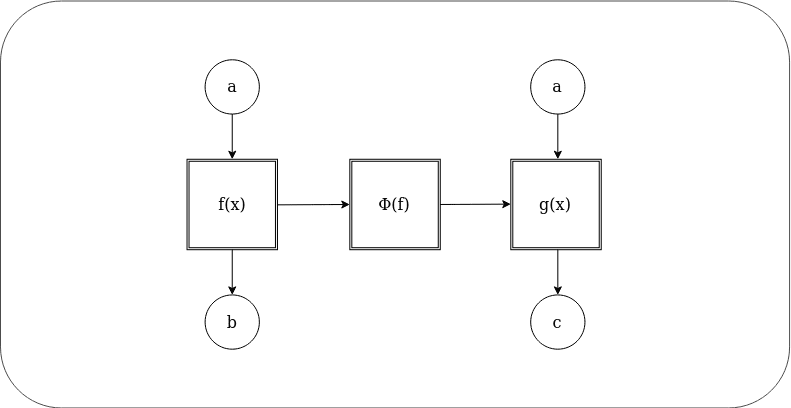An Interest In:
Web News this Week
- April 1, 2024
- March 31, 2024
- March 30, 2024
- March 29, 2024
- March 28, 2024
- March 27, 2024
- March 26, 2024
Take full advantage of high order functions - Examples in Javascript
Functions are more than just a way to avoid repetition in your code. The powerful concepts of functions as objects that can be manipulated and altered in runtime will improve the flexibility and scalability of your applications. Learn to use and write high order functions to raise the quality of your work.
Contents
- Introduction
- Functions as subroutines vs Functions as stored computations
- What are higher order functions?
- Some use cases for higher order functions
- Set aditional constraints to existing functions
- Create other functions with same logic but different parameters
- Use another function within a data structure
- Higher order functions for lists
- Complete example
- Conclusion
Introduction
Functions as subroutine vs Functions as stored computations
From a simplified perspective, functions are used to reduce repetition of code, separating some logic that accepts parameters and might (or not) return a value. However, from mathematics and the paradigm of functional programming, we get a more powerful concept of function, as an applicable computation.
Whats interesting about this subtle difference is that a computation can be stored as data too. In some dynamic languages like Javascript and Python, this means that you can manipulate functions as objects, as whats called first class citizens.
What are higher order functions?
In short, high order functions are the ones that use other functions as objects.
- Functions that take other functions as parameters.
- Functions whose return value is another function.
Some use cases for higher order functions
Before we go on, a quick remainder that the
x => ysyntax is equivalent tofunction(x){ return y }.
Set additional constraints to existing functions
Example: Function to limit the range of another functions output.
const clampedFunc = function(fun, min, max){ return (...args) => Math.max(min, Math.min(max, fun(...args)))}// Demonstrationsquared1 = x => x*xsquared2 = clampedFunc(squared1, 25, 100)squared1(3) // 9squared1(6) // 36squared1(12) // 144squared2(3) // 25squared2(6) // 36squared2(12) // 100Create other functions with same logic but different parameters
Example: Function to create linear functions.
const linear = function(m, n){ return (x) => m*x + n}// Demonstrationf1 = linear(1, 2)f1(10) // 12f1(20) // 22f2 = linear(2, -5)f2(7) // 9f2(8) // 11Use another function within a data structure
This is actually the most common use case. In fact, most modern languages have this kind of functions in their standard libraries. Were going to see some in the next section.
Higher order functions for lists
forEach: Apply a function to each element of the list and ignore the return values, if any.map: Apply a function to each element of the list and return a list of all returned values. In other languages its called apply.reduce: Apply a function of two arguments to the two first elements. Then, apply it again to the result and the third element. Then, apply it to the result and the fourth element, etc. In short, accumulate the value of a function for all the elements. In other languages its called fold.
For the following, a condition means a function that returns a boolean value.
some: Return true if at least one element satisfies a condition. In other languages its called any.every: Return true if all elements of the list satisfy a condition.filter: Return a list only with the elements that satisfy the condition.
Examples:
nums = [ 1, 2, 3, 4, 5 ]words = [ 'how', 'are', 'you' ]nums.forEach(x => console.log("- " + x))// returns nothing but prints nums as a bullet listnums.map( x => x*3 )// [ 3, 6, 9, 12, 15 ]words.reduce( (x, y) => x + ' ' + y )// 'how are you'nums.some( x => x > 5 )// falsewords.every( x => x.length == 3 )// truenums.filter(x => x % 2 == 0)// [ 2, 4 ]Complete example
Lets apply all we have learned to a single case.
// Function to concatenate other two functions (this is called composition)const compose = function (f1, f2){ return (...args) => f2(f1(...args))}// Function to compose any number of functions (general composition)const gCompose = function(fs){ return fs.reduce(compose)}// Function to generate custom formatter functionsconst custom_fmt = function(text, variable){ return (value) => text.replace(variable, value)}// Convert USD to Eurosconst usd2eur = function(x){ return x/1.2}// Fix the precision a number to 2const fix2 = function(x){ return x.toFixed(2)}// Store the functions in the order we want to apply themmyComputation = [usd2eur, fix2, custom_fmt("Cost in EUR: x", "x")]// Compose them into a single functionmyComputationFunc = gCompose(myComputation)// Apply the computation we just created to each element of our list and print the resultusdCosts = [2.50, 10.99, 3.3, 5.72]usdCosts.map(myComputationFunc).forEach(x => console.log('-',x))/* Console output- Cost in EUR: 2.08- Cost in EUR: 9.16- Cost in EUR: 2.75- Cost in EUR: 4.77*/Conclusion
For a small example, this approach is somewhat excessive, but illustrative. It is important to know how high order functions work and what possibilities they offer:
- Minimize the use of loops and branches in your code, improving legibility.
- Help you abstract and generalize processes, making the program more flexible and scalable.
- Reduce the code of large applications with atomic computations applied to data that might require more or less processing or where the required transformations change during execution.
Recommended reading

I made a recommendation system for Stack Overflow unanswered questions
MiguelMJ Jan 15 1 min read
Original Link: https://dev.to/miguelmj/take-full-advantage-of-high-order-functions-examples-in-javascript-4ibg
Dev To
 An online community for sharing and discovering great ideas, having debates, and making friends
An online community for sharing and discovering great ideas, having debates, and making friendsMore About this Source Visit Dev To



